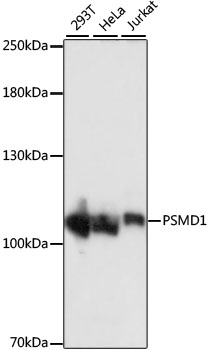| Background: | The 26S proteasome is a multicatalytic proteinase complex with a highly ordered structure composed of 2 complexes, a 20S core and a 19S regulator. The 20S core is composed of 4 rings of 28 non-identical subunits; 2 rings are composed of 7 alpha subunits and 2 rings are composed of 7 beta subunits. The 19S regulator is composed of a base, which contains 6 ATPase subunits and 2 non-ATPase subunits, and a lid, which contains up to 10 non-ATPase subunits. Proteasomes are distributed throughout eukaryotic cells at a high concentration and cleave peptides in an ATP/ubiquitin-dependent process in a non-lysosomal pathway. An essential function of a modified proteasome, the immunoproteasome, is the processing of class I MHC peptides. This gene encodes the largest non-ATPase subunit of the 19S regulator lid, which is responsible for substrate recognition and binding. Alternatively spliced transcript variants have been found for this gene. |
| UniProt Protein Function: | Component of the 26S proteasome, a multiprotein complex involved in the ATP-dependent degradation of ubiquitinated proteins. This complex plays a key role in the maintenance of protein homeostasis by removing misfolded or damaged proteins, which could impair cellular functions, and by removing proteins whose functions are no longer required. Therefore, the proteasome participates in numerous cellular processes, including cell cycle progression, apoptosis, or DNA damage repair. |
| NCBI Summary: | The 26S proteasome is a multicatalytic proteinase complex with a highly ordered structure composed of 2 complexes, a 20S core and a 19S regulator. The 20S core is composed of 4 rings of 28 non-identical subunits; 2 rings are composed of 7 alpha subunits and 2 rings are composed of 7 beta subunits. The 19S regulator is composed of a base, which contains 6 ATPase subunits and 2 non-ATPase subunits, and a lid, which contains up to 10 non-ATPase subunits. Proteasomes are distributed throughout eukaryotic cells at a high concentration and cleave peptides in an ATP/ubiquitin-dependent process in a non-lysosomal pathway. An essential function of a modified proteasome, the immunoproteasome, is the processing of class I MHC peptides. This gene encodes the largest non-ATPase subunit of the 19S regulator lid, which is responsible for substrate recognition and binding. Alternatively spliced transcript variants have been found for this gene.[provided by RefSeq, Jul 2010] |
| UniProt Code: | Q99460 |
| NCBI GenInfo Identifier: | 51704332 |
| NCBI Gene ID: | 5707 |
| NCBI Accession: | Q99460.2 |
| UniProt Related Accession: | Q99460 |
| Molecular Weight: | 106kDa |
| NCBI Full Name: | 26S proteasome non-ATPase regulatory subunit 1 |
| NCBI Synonym Full Names: | proteasome 26S subunit, non-ATPase 1 |
| NCBI Official Symbol: | PSMD1 |
| NCBI Official Synonym Symbols: | S1; P112; Rpn2 |
| NCBI Protein Information: | 26S proteasome non-ATPase regulatory subunit 1 |
| UniProt Protein Name: | 26S proteasome non-ATPase regulatory subunit 1 |
| UniProt Synonym Protein Names: | 26S proteasome regulatory subunit RPN2; 26S proteasome regulatory subunit S1; 26S proteasome subunit p112 |
| Protein Family: | 26S proteasome non-ATPase regulatory |
| UniProt Gene Name: | PSMD1 |







